Have you ever thought about what secrets ancient Egypt might hold? The Lost City of Aten, also known as So’oud Atun, was discovered recently. It dates back about 3,400 years to Pharaoh Amenhotep III’s time. Found near Luxor, it gives us a peek into life, trade, and beliefs in Egypt’s peak power.
In 2020, archaeologists found the Lost City of Aten, calling it a major discovery. It shows a city full of life, with bakeries, offices, and homes. They found things like scarab beetle amulets and pottery, revealing how people lived and worked. As they keep exploring, they’re learning more about ancient Egypt than ever before.
Key Takeaways
- The Lost City of Aten dates back over 3,400 years to the reign of Pharaoh Amenhotep III.
- Discovered near Luxor, the city contains well-preserved structures such as bakeries and residences.
- Artifacts found, including scarab amulets and pottery, reflect the daily lives of ancient Egyptians.
- Evidence of joint rule during its construction by Amenhotep and Akhenaten has been revealed.
- The discovery is likened to an ancient Egyptian Pompeii, showing amazing preservation.
The Discovery of the Lost City of Aten
The Aten lost city is a huge ancient city found in Egypt. It was discovered in September 2020. It dates back around 3,000 years, during Pharaoh Amenhotep III’s reign.
Archaeologists found neighborhoods with mud-brick walls up to 10 feet high. This makes the site both fascinating and well-preserved.
In about seven months, a big administrative and industrial settlement was uncovered. They found jewelry, pottery, and scarab beetle amulets. These show the city’s rich culture.
The city had buildings like a bakery and homes. This shows it had a structured society that supported a large workforce.
Experts are learning about life 3,000 years ago from the ruins. They found tools, ovens, and storage pottery. This is one of the biggest discoveries like the tomb of Tutankhamun.
Historical Significance of the Lost City

The lost city of Aten is very important. It shows us what life was like in ancient Egypt during a time of great prosperity. It was built around 1391 to 1353 B.C. during Amenhotep III’s rule. This place gives us a peek into a bustling city.
Aten is close to famous ancient Egyptian sites like the Colossi of Memnon and the Ramesseum. The found artifacts, from pottery to baking tools, show a hardworking community. There’s evidence of a bakery and special areas for administration, showing a well-organized society.
Things like mud bricks with Amenhotep’s seal and homes with controlled entry show smart governance. This city is a key part of Egypt’s history, adding to our knowledge of ancient civilizations.
Inscriptions tell us Amenhotep and Akhenaten ruled together here. This adds to our understanding of Egypt’s history during changes. Excavations have found interesting things, like a burial site and rock-cut tombs. These discoveries make us want to learn more about Egypt’s history.
The discovery of Aten helps us see the greatness of Amenhotep III’s time. It also helps us understand how ancient civilizations have influenced Egypt’s culture and history today.
Amenhotep III: The Pharaoh Behind Aten
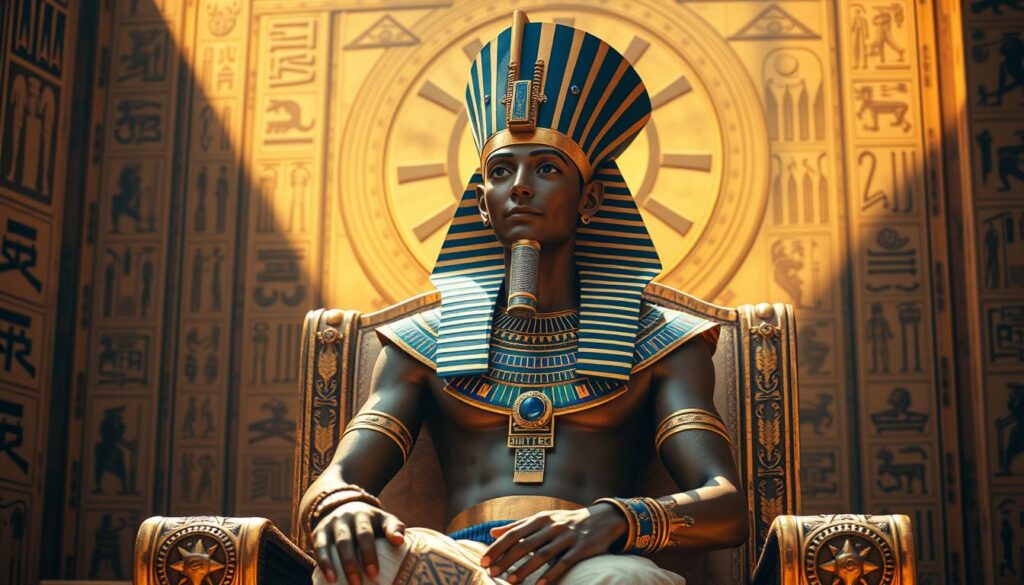
Amenhotep III ruled Egypt from 1386 to 1349 BCE. He is known as one of the most powerful leaders of ancient Egypt. His building projects show his ambition and the wealth of his time.
The lost city of Aten, found near Luxor, highlights his reign. It shows the administrative power during his rule.
The city of Aten dates back about 3,000 years. It’s the largest city found in Egypt, showing Amenhotep III’s big projects. Excavations started in September 2020, revealing amazing structures like bakeries and homes.
Discoveries include mud bricks with Amenhotep III’s seals and many artifacts. These show the culture of ancient Egypt. A bakery area suggests a society with a large workforce.
Inscriptions mention “the dazzling Aten,” linking the site to the god Aten. This god became more important under Amenhotep III’s successors.
The city of Aten gives us a glimpse into Amenhotep III’s era. Ongoing excavations will help us understand more about this great pharaoh and ancient Egypt.
Excavation Process and Techniques Used
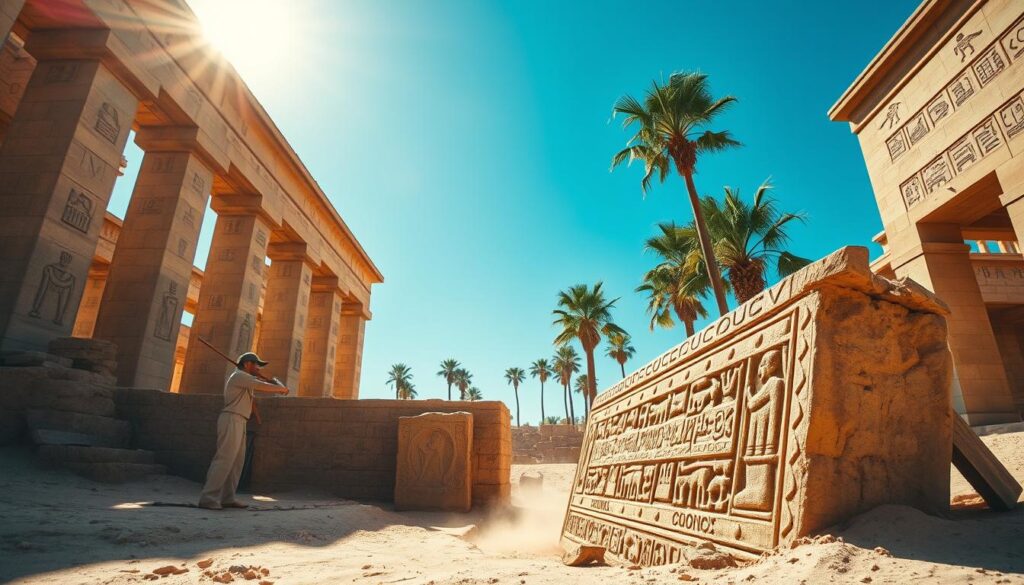
The excavation at Aten followed a detailed plan to keep history intact. It mixed old and new methods for a full view of the site. First, they focused on the city’s southern parts.
They started with stratigraphic excavation, uncovering the city layer by layer. This method helped avoid damage and document each find well. Ground-penetrating radar also helped find hidden features under the sand.
They found seven districts in the City of the Dazzling Aten. District 2 was key for food, with big storage and kitchens. Finds like blue pottery showed it was a lively place.
They found workshops for textiles, leather, and stone carving. This showed the complexity of life in Aten under Amenhotep III. It greatly enriched our knowledge of ancient Egyptian society.
| District | Main Function | Key Findings |
|---|---|---|
| District 1 | Residential Area | Houses with 10-foot walls, domestic artifacts |
| District 2 | Food Processing | Kitchens, storage of dried meat |
| District 3 | Production Area | Workshops for various crafts |
| District 4 | Administration | Documentation structures, official seals |
| District 5 | Religious | Artifacts related to goddess Hathor, amulets |
| District 6 | Burial Sites | Gravesites with offerings |
| District 7 | Bakery | Ovens, storage for grains |
This detailed excavation at Aten has opened new paths to understanding ancient Egyptian life. It sets the stage for more discoveries and exploration.
Uncover the Lost City of Aten in Ancient Egypt
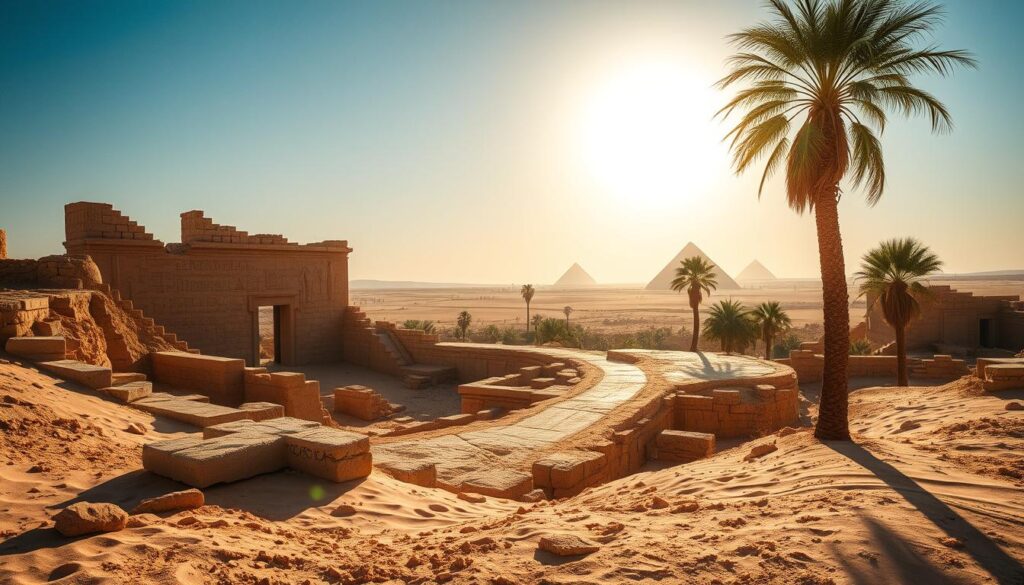
The city of Aten is near Luxor, on the west bank of the Nile in Upper Egypt. It’s close to many important historical sites. Founded nearly 3,400 years ago, it shows a rich time in Egyptian history.
Location and Geographic Context
Exploring Aten reveals a key settlement from Egypt’s wealthiest era. Built between 1386 and 1353 BCE, it was a center for administration and industry. Known as the “Pompeii of Ancient Egypt,” it offers a glimpse into ancient Egyptian life and city planning.
Key Archaeological Techniques Employed
Archaeologists use both old and new methods to uncover Aten. They use remote sensing and aerial photos to understand the site before digging. This careful approach helps preserve artifacts and maps the city’s layout, showing homes, workshops, and buildings.
Artifacts Unearthed from Aten
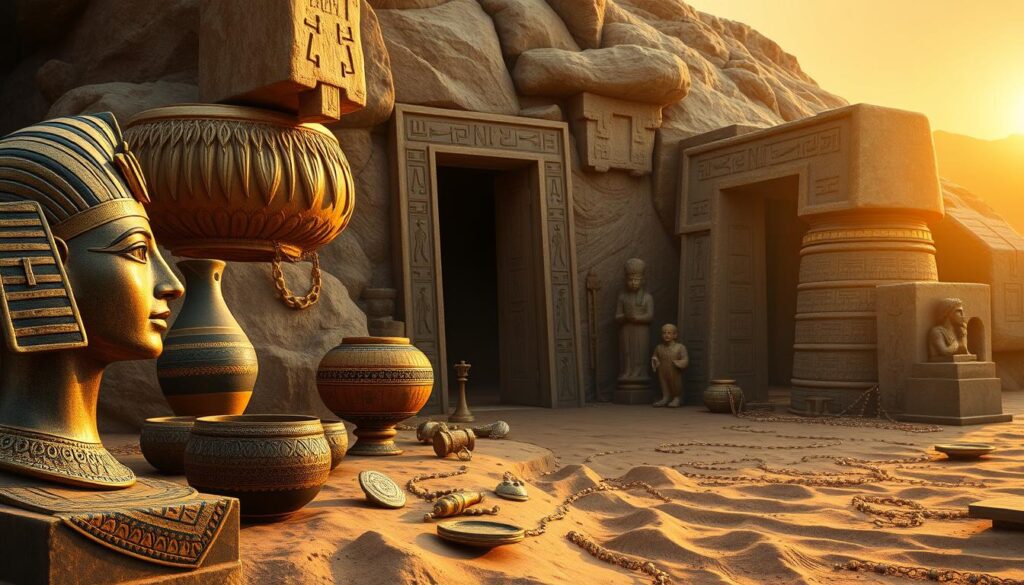
The lost city of Aten in Egypt has revealed many artifacts. These items show us how people lived back then. They include ancient tools and pottery that tell us about daily life under Amenhotep III.
- Jewelry items like rings and scarabs
- Decorative pottery vessels
- Statuettes and clay caps
- Ancient tools for weaving, spinning, and glass-making
- Well-preserved ovens and storage pottery in a large bakery
The bakery complex shows Aten’s industrial side. It shows a community with skilled craftsmen. They made sure everyone had enough food.
Archaeologists found an administrative district and homes too. This shows how organized life was in Aten. These finds help us understand the city’s social and economic life. They make Aten a key site for Egyptology research.
Societal Insights from the Lost City
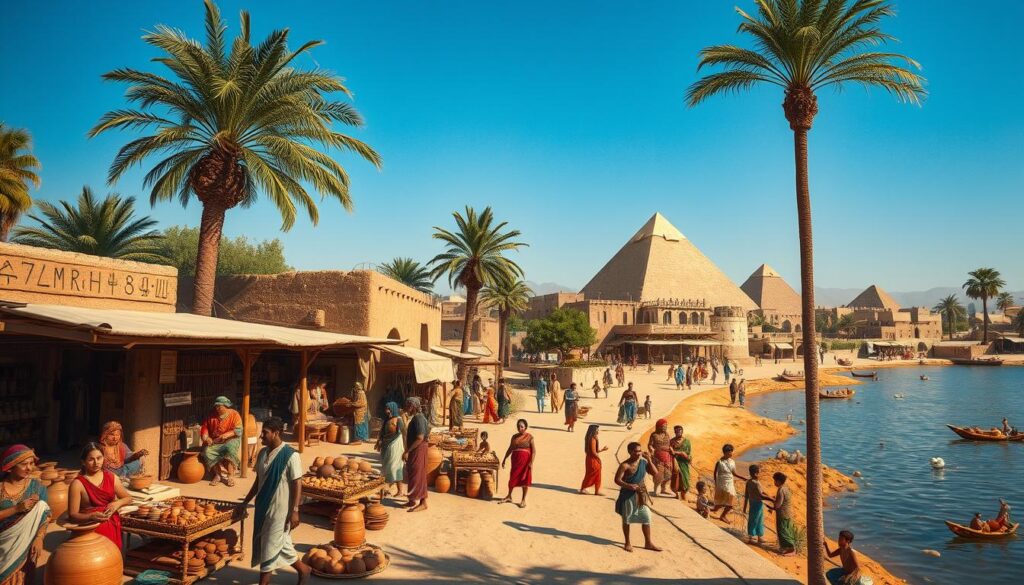
The lost city of Aten in ancient Egypt offers deep insights into society. Archaeologists have found a lively community that shows us daily life and religious practices. This city proves that ancient Egyptians lived in well-organized cities.
Everyday Life in Ancient Aten
In ancient Aten, people lived in a well-organized way. Excavations have uncovered tools, pottery, and household items, showing a strong economy. There were storage places and workshops for different trades, showing the city’s role in daily life.
There were special areas for craftsmen like jewelers and glazers. A big bakery and kitchens show the city could feed its people and guests.
Religious Practices Reflected in Artefacts
Religion was a big part of life in Aten. Many artifacts related to worship have been found, like amulets and items for funerals. These items were not just for worship but also tell us about the city’s spiritual story.
Discoveries of burials and pottery with inscriptions show deep respect for gods and rituals. This respect was key to the city’s life.
| Aspect | Details |
|---|---|
| Artifacts Found | Tools, pottery, jewelry, religious objects |
| Workshops | Brickmakers, glazers, jewelers |
| Baking Facilities | Large bakery and multiple kitchens |
| Cemetery | Rock-cut tombs similar to those in the Valley of the Kings |
| Daily Activities | Economic transactions, crafts, and community festivals |
Exploring Aten gives us a glimpse into ancient Egyptian life and beliefs. It shows a society full of culture and innovation.
Comparisons to Other Lost Egyptian Cities
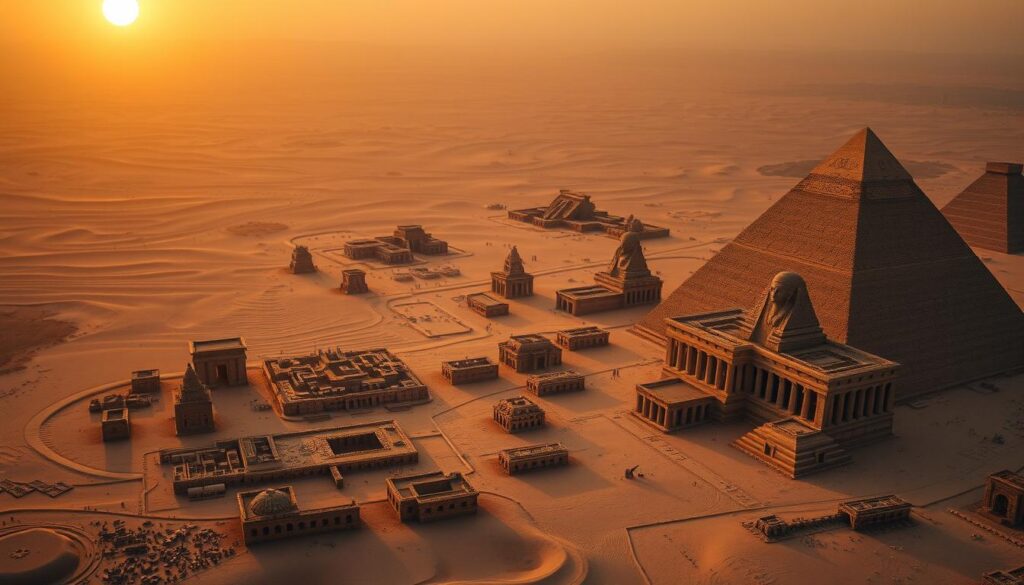
The journey into lost Egyptian cities history is filled with fascinating sites. Each has its own story and architectural beauty. Aten is special, standing out against cities like Amarna, Heracleion, and Tanis. This comparison helps us understand ancient Egypt’s urban growth and culture.
Aten was founded by Amenhotep III around 1386–1353 BCE. It shows a design focused on function. The city had workshops, homes, and government areas, showing the complexity of life back then. Amarna, built by Akhenaten, had a unique design but was abandoned after 14 years. Akhenaten’s rule changed Egyptian culture, but Amarna was erased from history.
Heracleion was a major port until the 8th century CE. It sank, showing how fragile civilizations can be. Tanis was a key trade center but declined with political changes, showing how cities can rise and fall.
Aten is like the “Pompeii of Ancient Egypt” because of its amazing preservation. Archaeologists found three palaces and different neighborhoods, giving us a glimpse into life 3,000 years ago. This is unlike Amarna and Heracleion, which have less preserved history.
Studying Aten with other lost Egyptian cities shows us a lot about urban life. It reveals a rich history, woven from many historical threads.
Future Prospects of Excavation at Aten

The excavation at Aten is set to reveal exciting new insights. Each phase brings us closer to understanding this ancient site. Researchers aim to uncover daily life, trade, and community organization in this lost city.
What We Hope to Discover
Archaeologists are now focusing on the northern section of Aten. This area could reveal more about the city’s layout and architecture. They also hope to find burial sites and domestic structures.
These discoveries will help us understand social hierarchies and cultural practices. They will give us a deeper look into the lives of Aten’s people.
The Importance of Continued Research in Egyptology
The excavation at Aten shows how important Egyptology research is. It helps us understand ancient civilizations and how they relate to today. Every artifact and structure found adds to Aten’s story.
This research teaches us valuable lessons from the past. It shows the importance of archaeology in connecting us to ancient Egypt.
Conclusion
The discovery of the Lost City of Aten is a major breakthrough in understanding ancient Egypt. It shows how important archaeological finds are. This site gives us a glimpse into the lives of people over 3,000 years ago.
Artifacts like scarabs and pottery reveal a lot about ancient society. They tell us about their social structure, beliefs, and work. This helps us see how they lived and what they believed in.
Exploring the city shows it was a bustling place. It had advanced management, lively markets, and special burial customs. The team started digging in September 2020 and has already found many interesting things.
These discoveries make us excited for what else might be found. The team is eager to learn more about this ancient place. Their work could uncover even more secrets of ancient Egypt.
This story of Aten is not just about finding old ruins. It’s about the endless stories hidden in ancient sites. Protecting these sites is key to learning from history. It also inspires future generations to value our cultural heritage.

